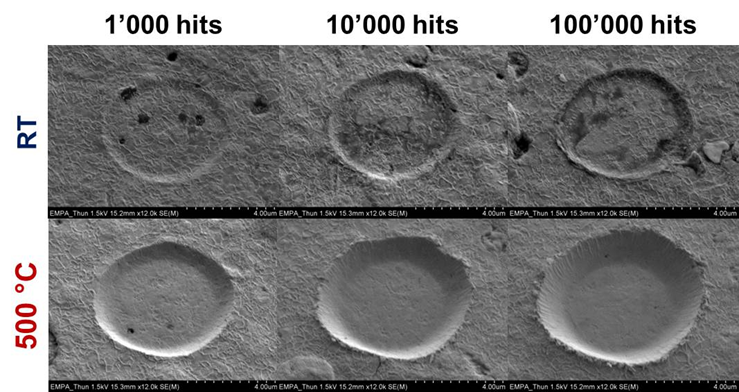IMPACT
Many industrial processes cause vibrations which can cause excessive wear over the lifetime of the components from repetitive contact, sometimes at high frequencies, between two surfaces. Such repetitive loading can often cause fatigue and ultimately lead to failure through significant plastic deformation, fracture or debonding (in the case of coatings). An understanding of the properties and processes of fatigue failure under service conditions is therefore crucial for the design and optimization of surfaces able to survive for long service lifetimes. The effects of high impact energies have traditionally been investigated using Hopkinson pressure bars, Charpy tests and various forms of actuation such as servo-hydraulic, electro-dynamic and electro-mechanical. Such macroscale tests may be expensive, inefficient and may not be able to simulate the many thousands of cycles which a component may see in service. Microscale evaluation is becoming more important as small scale devices (e.g., MEMS, sensors, etc.) suffer from the same fatigue failures and there is a lack of dedicated test instruments capable of simulating them. Some previous work has been done using conventional nanoindenters in oscillatory mode, but the high frequencies seen by many devices in service cannot be reached as most nanoindenters are limited to frequencies of the order of 1 Hz.
The Alemnis Standard Assembly (ASA) fitted with the Ultra High Strain Rate (UHSR) option is capable of an extremely wide range of strain rate. For example, with a maximum actuation speed of ̴8 mm/s and a micropillar with gage length of ̴4 µm, the effective strain rate can cover the range 0.0001/s up to a maximum of 2000/s, which equates to 8 orders of magnitude of strain rate! For dynamic impact testing, the standard load cell can be replaced by a dynamic load sensor (or “SmarTip”) which has a resonant frequency of around 10 kHz, which is two orders of magnitude greater than that of a classical load cell ( ̴ 600 Hz). The SmarTip can perform ultra high strain rate tests up to a maximum load of 1 N with only 30 µN RMS noise at 200 Hz acquisition.
Load-displacement curves obtained between room temperature and 500°C for impact tests on a CrN coating with 10k impacts. Shown is an overlay of curves from the 20th to the 40th impact.
To perform high frequency impact tests, the Alemnis system is used in open loop mode with a voltage amplitude set-point applied to the piezo displacement actuator, in order to define the displacement amplitude. For the example results presented here, the frequency used was 500 Hz and the displacement amplitude was 800 nm. For test durations of 2, 20 and 200 s, the 500 Hz frequency provides total impacts of 1k, 10k and 100k respectively, with the SmarTip load data collected with a sampling frequency of 50 kHz. The sample material was a piece of hardened tool steel, pulse plasma-nitrided to a depth of 120 µm and subsequently coated with Chromium Nitride (CrN) to a total thickness of 4.65 µm
Residual imprints from room temperature and 500°C nano-impact tests (1k and 100k) using a diamond flat punch onto CrN coated nitrided tool steel
The great advantage of doing impact testing in-situ in the SEM is that, after impact testing, the sample surface can be directly imaged using high resolution SEM to analyse the residual imprints and learn more about the increase in depth as a function of the number of impacts. Additionally, the combination of the UHSR module with the high temperature module (HTM-800) means that the effect of impact testing can also be correlated to the typical in-service operating temperature of the material being investigated.
Selected References
- J. P. Best, G. Guillonneau, S. Grop, A. A. Taylor, D. Frey, Q. Longchamp, T. Schär, M. Morstein, J-M Breguet, J. Michler, High temperature impact testing of a thin hard coating using a novel high-frequency in situ micromechanical device, Surface and Coatings Technology 333 (2018) 178–186. https://doi.org/10.1016/j.surfcoat.2017.10.072.
- J. P. Best, M. Polyakov, D. Shinde, M. H. Colliander, J. Wehrs, J. Michler, M. Morstein, Ni nanocluster composites for enhanced impact resistance of multilayered arc-PVD ceramic coatings, Surface and Coatings Technology 354 (2018) 360–368. https://doi.org/10.1016/j.surfcoat.2018.07.102.
- D. Tumbajoy-Spinel, S. Descartes, J-M Bergheau, V. Lacaille, G. Guillonneau, J. Michler & G. Kermouche, Assessment of mechanical property gradients after impact-based surface treatment: application to pure α-iron, Materials Science and Engineering: A 667 (2016) 189-198. https://doi.org/10.1016/j.msea.2016.04.059




